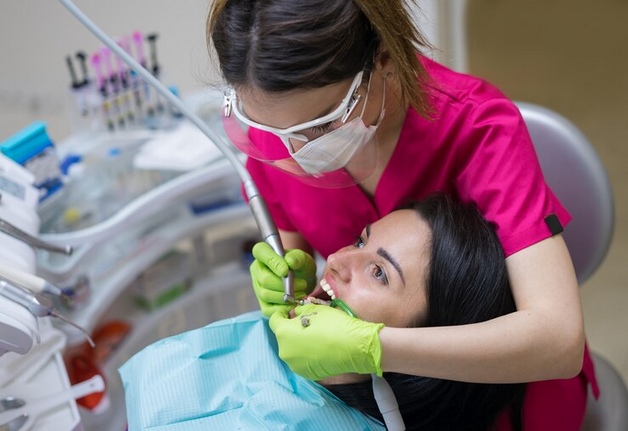Introduction
Maintaining good oral health is essential not only for a beautiful smile but also for overall well-being. Professional teeth cleaning, performed by dental professionals, plays a crucial role in preserving oral hygiene and preventing various dental problems. This paper explores the importance of professional teeth cleaning, its benefits, procedures involved, potential risks, and the role of advanced technologies in modern dental cleaning practices.
Importance of Professional Teeth Cleaning
Oral Health and Overall Well-being
The health of our teeth and gums directly impacts our overall health. Poor oral hygiene can lead to various dental issues such as cavities, gum disease, and bad breath. Regular professional teeth cleaning helps remove plaque and tartar buildup, reducing the risk of these problems and promoting oral health.
Prevention of Dental Diseases
Professional teeth cleaning is essential for preventing dental diseases. Plaque buildup, if not removed, can harden into tartar (calculus), which cannot be removed by brushing alone. Tartar buildup increases the risk of gum disease and tooth decay. Professional cleaning effectively removes plaque and tartar, thereby lowering the risk of these diseases.
Benefits of Professional Teeth Cleaning
Removal of Plaque and Tartar
During a professional teeth cleaning session, a dental hygienist or dentist uses specialized tools to remove plaque and tartar from the teeth and gum line. This process, called scaling, helps prevent gum inflammation (gingivitis) and more severe gum disease (periodontitis).
Fresher Breath
Persistent bad breath (halitosis) is often caused by bacteria in the mouth, which can be exacerbated by food particles trapped between teeth or along the gum line. Professional cleaning removes these bacteria and food debris, resulting in fresher breath and improved oral hygiene.
Brighter, Whiter Teeth
Stains on the teeth from coffee, tea, tobacco, and other sources can be effectively removed during professional cleaning. Polishing the teeth after scaling can also help achieve a brighter smile by removing surface stains and smoothing the tooth surfaces.
Early Detection of Dental Problems
Regular dental check-ups that include professional cleaning allow dentists to detect early signs of dental issues such as cavities, cracked teeth, and gum disease. Early intervention can prevent these problems from worsening and requiring more extensive treatment.
Procedures Involved in Professional Teeth Cleaning
Examination and Assessment
Before starting the cleaning procedure, the dental hygienist or dentist performs a thorough examination of the teeth and gums. This examination helps identify areas of concern, such as cavities or signs of gum disease, which may require additional treatment.
Scaling
Scaling involves the removal of plaque and tartar from the tooth surfaces and below the gum line. Specialized dental tools, such as scalers and ultrasonic devices, are used to carefully scrape away these deposits without causing damage to the teeth or gums.
Polishing
After scaling, the teeth are polished using a rotating brush or rubber cup attachment with a gritty toothpaste-like substance. This process removes surface stains and smooths the tooth surfaces, enhancing the appearance of the teeth and making them more resistant to future plaque buildup.
Fluoride Treatment (Optional)
Some dental offices offer fluoride treatment following cleaning to strengthen the teeth and prevent tooth decay. Fluoride is applied as a gel, foam, or varnish and left on the teeth for a few minutes. It helps remineralize the enamel and reduce the risk of cavities.
Potential Risks and Considerations
Tooth Sensitivity
Some individuals may experience temporary tooth sensitivity after professional cleaning, especially if they have sensitive teeth or exposed dentin. This sensitivity typically resolves within a few days and can be managed with desensitizing toothpaste.
Gum Irritation
Aggressive scaling or improper technique during cleaning can cause temporary gum irritation or minor bleeding. However, skilled dental professionals minimize these risks by using appropriate techniques and tools.
Discomfort During Scaling
For individuals with extensive plaque and tartar buildup, scaling may cause mild discomfort or sensitivity. Dental professionals can apply local anesthesia or offer numbing gels to alleviate discomfort and ensure a more comfortable experience.
Role of Advanced Technologies in Modern Dental Cleaning
Ultrasonic Scalers
Ultrasonic scalers use high-frequency vibrations to break down and remove plaque and tartar from the teeth and gums. These devices are effective in deep cleaning and are gentler on tooth enamel compared to traditional manual scalers.
Air Polishing Systems
Air polishing systems use a combination of water, air, and fine powder particles to remove surface stains and plaque from the teeth. This method is less abrasive than traditional polishing techniques and can achieve excellent results in stain removal.
Digital Imaging and Diagnostic Tools
Advanced imaging technologies such as digital X-rays and intraoral cameras allow dental professionals to visualize and assess dental structures more accurately. These tools aid in diagnosing dental problems early and planning appropriate treatments.
Conclusion
In conclusion, professional teeth cleaning dentist cornerstone of preventive dental care, offering numerous benefits for oral health and overall well-being. From removing plaque and tartar to preventing dental diseases and enhancing the appearance of teeth, regular cleanings performed by dental professionals are essential for maintaining a healthy smile. Despite potential risks such as tooth sensitivity or gum irritation, modern dental technologies and techniques have significantly improved the safety and effectiveness of professional cleaning procedures. Embracing regular dental check-ups and cleanings not only ensures optimal oral health but also contributes to a confident smile and improved quality of life.





Comments